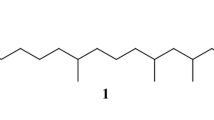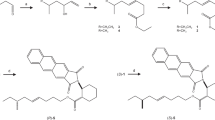Abstract
Preparation of a complete stereoisomeric library of 1,10-bisaboladien-3-ols and selected 10,11-epoxy-1-bisabolen-3-ols was pivotal for the identification of the aggregation pheromone of the brown marmorated stink bug, Halyomorpha halys. Herein, we describe syntheses of the remaining 10,11-epoxy-1-bisabolen-3-ols, and provide additional evidence on the assignment of relative and absolute configurations of these compounds by single-crystal X-ray crystallography of an intermediate, (3S,6R,7R,10S)-1-bisabolen-3,10,11-triol. To demonstrate the utility of this stereoisomeric library, we revisited the aggregation pheromone of the harlequin bug, Murgantia histrionica, and showed that the male-produced pheromone consists of two stereoisomers of 10,11-epoxy-1-bisabolen-3-ol. Employment of eight cis-10,11-epoxy-1-bisabolen-3-ol stereoisomeric standards, two enantioselective GC columns, and NMR spectroscopy enabled the identification of these compounds as (3S,6S,7R,10S)-10,11-epoxy-1-bisabolen-3-ol and (3S,6S,7R,10R)-10,11-epoxy-1-bisabolen-3-ol, which are produced by M. histrionica males in 1.4:1 ratio.





Similar content being viewed by others
References
Aldrich JR, Oliver JE, Lusby WR, Kochansky JP, Lockwood JA (1987) Pheromone strains of the cosmopolitan pest Nezara viridula (Heteroptera: Pentatomidae). J Exp Zool 244:171–175
Aldrich JR, Lusby WR, Marron BE, Nicolaou KC, Hoffmann MP, Wilson LT (1989) Pheromone blends of green stink bugs and possible parasitoid selection. Naturwissenschaften 76:173–175
Baker R, Borges M, Cooke NG, Herbert RH (1987) Identification and synthesis of (Z)-(1′S,3′R,4′)-(−)-2-(3′,4′-epoxy-4′-methylcyclohexyl)-6-methylhepta-2,5-diene, the sex pheromone of the southern green stink bug, Nezara viridula (L.). J Chem Soc Chem Commun 414–416
Blair M, Tuck KL (2009) A new diastereoselctive entry to the (1S,4R)- and (1S,4S)-isomers of 4-isopropyl-1-methyl-2-cyclohexen-1-ol, aggregation pheromones of the ambrosia beetle Platypus quercivorus. Tetrahedron Asymmetry 20:2149–2153
Borges M, Birkett M, Aldrich JR, Oliver JE, Chiba M, Murata Y, Laumann RA, Barrigossi JA, Pickett JA, Moraes MCB (2006) Sex attractant pheromone from the rice stalk stink bug, Tibraca limbativentris Stal. J Chem Ecol 32:2749–2764
de Oliveira MWM, Borges M, Andrade CKZ, Lauman RA, Barrigossi JAF, Blassioli-Moraes MC (2013) Zingiberenol, (1S,4R,1′S)-4-(1′,5′-dimethylhex-4′-enyl)-1-methylcyclohex-2-en-1-ol, identified as the sex pheromone produced by males of the rice stink bug Oebalus poecilus (Heteroptera: Pentatomidae). J Agric Food Chem 61:7777–7785
Flack HD (1983) On enantiomorph-polarity estimation. Acta Cryst A39:876–881
Frater G, Müller U (1989) Synthesis of (+)-(4S,8R)-8-epi- and (−)-(4R,8S)-4-epi-β-bisabolol. Helv Chim Acta 72:653–658
Hooft RWW, Straver LH, Spek AL (2008) Determination of absolute structure using Bayesian statistics on Bijvoet differences. J Appl Crystallogr 41:96–103
Khrimian A, Zhang A, Weber DC, Ho H-Y, Aldrich JR, Vermillion KE, Siegler MA, Shirali S, Guzman F, Leskey TC (2014) Discovery of the aggregation pheromone of the brown marmorated stink bug (Halyomorpha halys) through the creation of stereoisomeric libraries of 1-bisabolen-3-ols. J Nat Prod 77:1708–1717
Leal WS, Kuwahara S, Shi XA, Higuchi H, Marino CEB, Ono M, Meinwald J (1998) Male-released sex pheromone of the stink bug Piezodorus hybneri. J Chem Ecol 24:1817–1829
McBrien HL, Millar JG, Gottlieb L, Chen X, Rice RE (2001) Male-produced sex attractant pheromone of the green stink bug Acrosternum hilare (Say). J Chem Ecol 27:1821–1839
McBrien HL, Millar JG, Rice RE, McElfresh JS, Cullen E, Zalom FG (2002) Sex attractant pheromone of the red-shouldered stink bug Thyanta pallidovirens: a pheromone blend with multiple redundant components. J Chem Ecol 28:1797–1817
Moore CJ, Possner S, Hayes P, Paddon-Jones GC, Kitching W (1999) An asymmetric dihydroxylation route to (3R,5E)-2,6-dimethyl-2,3-epoxyocta-5,7-diene: the major volatile component from male fruit-spotting bugs. J Org Chem 64:9742–9744
Sharpless KB, Amberg W, Bennani YL, Crispino GA, Hartung J, Jeong K-S, Kwong H-L, Morikawa K, Wang Z-M, Xu D, Zhang X-L (1992) The osmium-catalyzed asymmetric dihydroxylation: a new ligand class and a process improvement. J Org Chem 57:2768–2771
Sheldrick GM (2008) A short history of SHELX. Acta Crystallogr A64:112–122
Terhune SJ, Hogg JW, Bromstein AC, Lawrence BM (1974) Four new sesquiterpene analogs of common monoterpenes. Can J Chem 53:3287–3293
Wallingford AK, Kuhar TP, Schultz PB, Freeman JH (2011) Harlequin bug biology and pest management in Brassicaceous crops. J Integr Pest Mgmt 2:H1–H4
Weber DC, Cabrera Walsh G, DiMeglio AS, Athanas MM, Leskey TC, Khrimian A (2014) Attractiveness of harlequin bug, Murgantia histrionica (Hemiptera: Pentatomidae), aggregation pheromone: field response to isomers, ratios and dose. J Chem Ecol, in press
Zahn DK, Moreira JA, Millar JG (2008) Identification, synthesis, and bioassay of a male-specific aggregation pheromone from the harlequin bug, Murgantia histrionica. J Chem Ecol 34:238–251
Zahn DK, Moreira JA, Millar JG (2012) Erratum to: identification, synthesis, and bioassay of a male-specific aggregation pheromone from the harlequin bug, Murgantia histrionica. J Chem Ecol 38:126
Acknowledgments
We thank Dr. Jocelyn G. Millar, University of California, Riverside, for sharing 1H NMR spectrum of the murgantiol described in Zahn et al. 2008. We express our gratitude to Michael M. Athanas, Anthony DiMeglio, Matthew Klein, and Meiling Z. Webb, for collecting, rearing, and volatile collection of the insects.
Author information
Authors and Affiliations
Corresponding author
Electronic supplementary material
Below is the link to the electronic supplementary material.
ESM 1
(PDF 101 kb)
Rights and permissions
About this article
Cite this article
Khrimian, A., Shirali, S., Vermillion, K.E. et al. Determination of the Stereochemistry of the Aggregation Pheromone of Harlequin Bug, Murgantia histrionica . J Chem Ecol 40, 1260–1268 (2014). https://doi.org/10.1007/s10886-014-0521-2
Received:
Revised:
Accepted:
Published:
Issue Date:
DOI: https://doi.org/10.1007/s10886-014-0521-2




